#and brock developing some sort of photographic memory
Explore tagged Tumblr posts
Note
@silverncats reminds me of our talk about Ash-Greninja!
Headcanons for the Sinnoh trio gaining an ability from their respective Lake Guardian? (Enhanced Reflexes for Ash, Astral Projection for Dawn, and Past Visions for Brock)
oooooo sure! hope i did alright with these!
Maybe Ash was used to seeing legendaries like that and gaining some kind of power from them, and Brock was on a slightly similar level, but Dawn was understandably freaking out.
She couldn’t really control her astral projection at first. She was honored that Mesprit chose and trusted her, sure, but it was the weirdest feeling and pretty hard to control.
Brock had it slightly easier with past visions from Uxie. Actually, having that ability made some of his work with pokemon a bit easier, since he could pinpoint certain things about them when he took care of them.
And Ash? He already was the kind of person who seemed like he could handle anything, enhanced reflexes were nothing new to him. …Actually, he hardly noticed it.
He was able to help the two of them adjust a bit better, or as much as he could. Brock and Dawn both struggled a little, but once they started getting the hang of it, maybe they could actually be useful.
#reblog#|→ diamond digging#those are interesting#in fact op has a lot of cool hcs for pokemon#ash becoming even more impulsive or developing highly accurate hunches#dawn becoming an empath (derogatory)#and brock developing some sort of photographic memory#cool ideas honestly
31 notes
·
View notes
Text
On Seeing, A Journal. #278 Andrew Moore, "Dirt Meridian,” a book review.
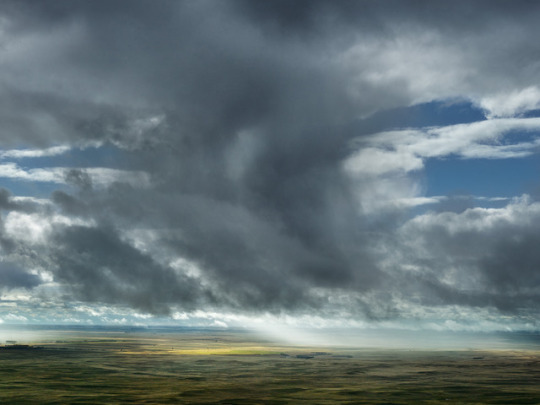
Sun Through Rain. ©Andrew Moore
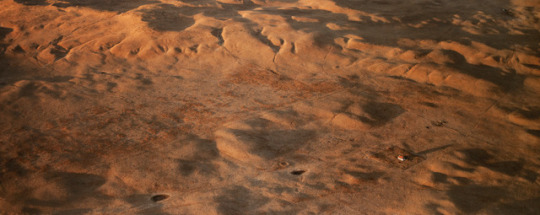
Schoolhouse, China Pasture. ©Andrew Moore
I receive, daily, the internationally informative photography news site

The Eye of Photography from the former editor-in-chief of French Photo Magazine and now editor-in-chief of The Eye of Photography, Jean-Jacques Naudet. This daily posting is phenomenally valuable, covering all sorts of photography events, portfolios of photographers throughout the world, gallery shows, museum exhibitions, etc.
The site is free, though as an aside they can use financial help for their service. Apart from having contributed features from time to time, I have no affiliation with them, I’m only interested in seeing the on-going success of something that publishes so much information and imagery every day.
Other important sources include AtEdge and Graphis.
Each of these open up to a wide world of brilliant photographers, designers, and other creatives.
A recent post contained an article about the The Yancy Richardson Gallery in New York City. The images of Andrew Moore who is represented by the gallery particularly caught my eye. I went to his site ((http://www.andrewlmoore.com)) and was so moved by his body of work that I bought his recent book, "Dirt Meridian.”
I do that, buy and collect photography books. Along with the internet, books are my major source of self-education. I am well aware that if I am to grow in this visual art, it’s imperative that I study, continually, tenaciously. It’s essential to gain, maintain and expand a vast visual data bank if one desires to create unique, original and exciting work. For photography, one needs to look, study, and look even more, reviewing and surveying everything available in galleries, web sites, periodicals, museums, presentations and, yes, books. Our brains are such that images drop out; constant replenishment is needed for any sort of positive development, success, and even survival in this challenging art. It’s essential to recognize what’s been done before in order to avoid repetition. Knowing what hasn’t been done, or done well enough, comes when one has seen – and keeps seeing -- a vast range of imagery.
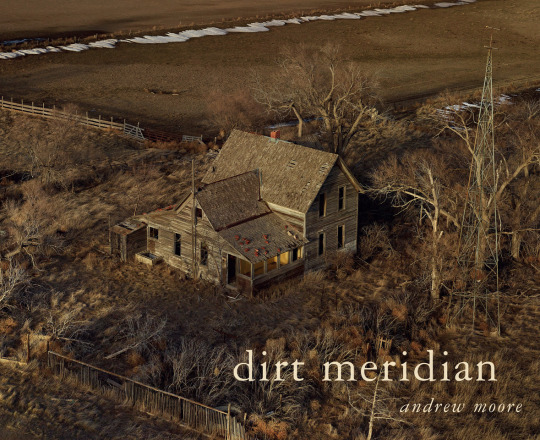
When “Dirt Meridian” arrived, I opened it and couldn’t put it down, studying every image. And, as I always do with a new book of photographs, I left it out, opened, on a counter I pass daily, so that I could look at it again and again and imprint the images in my memory.
This is not the kind of photography I endeavor to create in the controlled environment of a studio (or a pool, my particular kind of studio). Moore’s work is done outdoors, in this case in the vast, almost empty space of the great plains of middle America. What he shows us are sand hills and sky and weather and cattle. And the Badlands and old abandoned barns and buffalo and meadows and creeks, windmills and wildlife. He also shows the determined struggle of the human spirit against the toughest elements, and the effect of those on deserted homesteads.
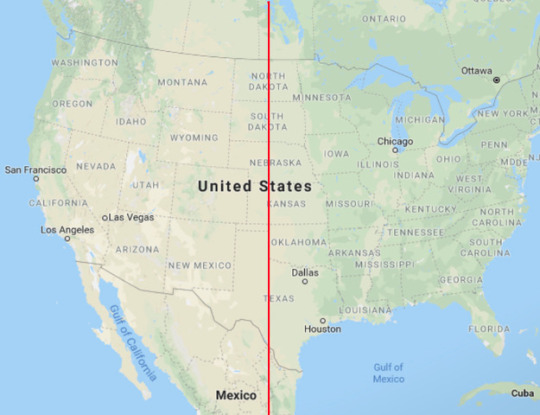
America, its 100th meridian.
Moore’s epic visions of the vast treeless space in the 100th meridian, cutting through North and South Dakota, Nebraska, Kansas, Oklahoma, and Texas, are all about space -- empty sprawling and seemingly infinite space. The images are intoxicating, filled with magnificent beauty in the loneliness that is the trackless expanse of seemingly endless land. From his Acknowledgement: “…the land’s beauty lies in its vast and sublime emptiness."
I wrote to Moore and learned, happily, that his NYC studio/office is located only a few blocks from mine. So, I invited him for lunch and an in-person review of his magnificent photographs.
Working on this book project, he spent weeks at a time on many trips from the East, met many individuals and recorded their stories, histories, lives. Each photograph is accompanied by text containing fascinating information which provides a rich understanding of the work.
Moore made many of the photographs from a Cessna 180 single-engine plane flown by Doug Dean. They attached his medium format digital camera to one of the plane’s wing struts, using a screen and remote control from the passenger seat.
They flew low, yielding a unique perspective. This technique is one important reason why the images look so different from photographs of this area I’ve seen before. He spoke of the emptiness as a spiritual reservoir, a spiritual landscape. He wrote in the Acknowledgements, “the intimate seemed conjoined to the infinite."
During the project he moved from north to south, contrasting open spaces with cluttered, claustrophobic interiors, rich with poor, immigrants and native born, industrial scenes with mythic landscapes, all of which he explained was a metaphor for the sense of possibility, of hope that tomorrow will be a better day.
In the book his pilot wrote, “I hope you take pause, if only for a moment, to consider the story of this land, where second chances are few, and how the decisions we make today will impact the generations to follow."
Moore allowed me to choose images I personally wished to use for this review.
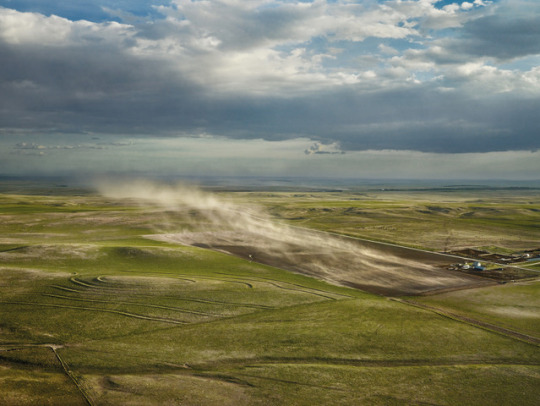
Storm Blow. ©Andrew Moore
From the book: “Sheridan County, Nebraska. These dry, fallow lands and terraces lie to the southeast of Clinton. The wind coming out of the north was blowing at over 70 mph. When choosing the angle approach to a subject, Doug Dean piloted us, if possible, into a headwind, since that slowed the plane down and allowed a bit more time for picture making. On this day we had little choice but to let a powerful tailwind take us on a Nantucket sleigh ride if we wanted to catch this billowing cloud of white dirt."
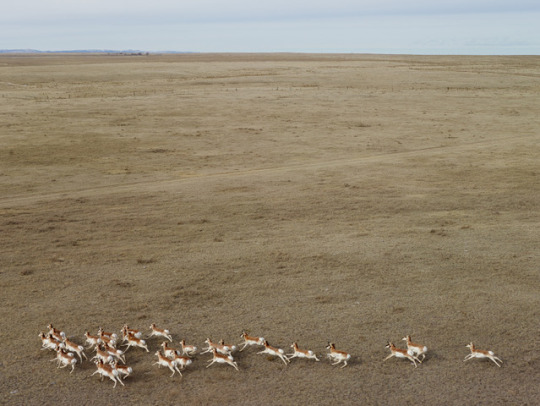
Pronghorn Antelope. ©Andrew Moore
From the book: “A herd of the wild antelope, which in wintertime can number into the hundreds, roams the high plains that stretch toward the Big Horn Mountains in the background. Early pioneer cattlemen noticed that the native grass animals roaming this area tasted particularly good, and to this day Niobrara County grass has become famous among livestock buyers for the finish it gives cattle.”
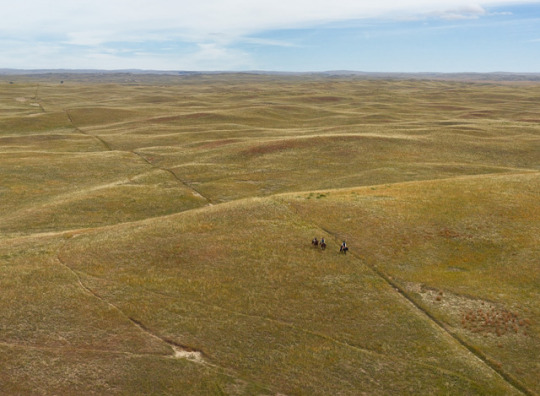
Riding Fence. ©Andrew Moore
From the book: “Sheridan County, Nebraska, 2013. Heidi and Brock Terrell and their son Royal (led by their red heeler) ride fence along their land in Sheridan County. They not only raise both cattle and sheep but they also farm soybeans and sugar beets. Heidi is a sixth generation descendant of Jules Sandoz, among the earliest homesteaders in the area. Better known as ‘Old Jules,’ legendary for his cussedness and his justly famous tenacity, he was immortalized in the biography of the same name written in 1935 by daughter Mari Sandoz.”
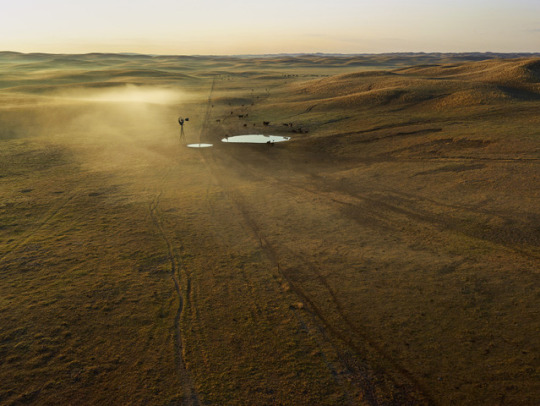
First Light. ©Andrew Moore
From the book: "Cherry County, Nebraska, 2013. Cattle and heron share a drink at the tank in the residual morning fog. Much of the success of cattle ranching in the Sandhills is due to the shallow reach down to the Ogallala Aquifer. In some places it's only six feet to water, so one can easily and cheaply put down a windmill in order to water livestock anywhere in the vastness of this terrain. (There are many sub-irrigated meadows that provide hay at the driest times.) The hilly landscape provides the herd with protection from the wind and snow. However, the quality of the grass is not as good as on hard soil land, so it can still take 20 to 30 acres to support just one cow/calf pair."

Round Up Number 2. ©Andrew Moore
From the book: “McKenzie County, North Dakota, 2005. Branding day at the Hepper Ranch outside the town of Keene. In the shadows of the Blue Buttes, amidst lush May grass, family, friends, and neighbors (and several dogs) help round up this herd of 300 cow/calf pairs. The large crew included five heelers, six sets of floppers, branders, vaccinators, and iron tenders. The older more experienced cowboys do the actual branding while the younger folks who wrestle the calves are known as floppers.”
In the book’s introduction, Kent Haruf wrote, “These are wonderful photographs, clear, and evocative, unsentimental, they seem to understand the sacredness of the country. They suggest its holiness."
Howard Schatz, November, 2018.
254 notes
·
View notes
Link
On Good Friday 1958, thousands gathered in London’s Trafalgar Square to protest nuclear weapons. They were responding to a string of test blasts conducted by the United Kingdom, the third nation to join the nuclear club after the US and USSR.
For the next four days, the bravest among them marched to Aldermaston, a small village 50 miles west of London where British nuclear weapons were designed and stockpiled.
On the protesters’ signs and banners, a new symbol was making its first appearance. Gerald Holtom, a designer and a pacifist, had developed it specifically for the march just a few weeks prior. He believed that a symbol would make the message stronger.
He was right: The symbol was adopted soon after by the Campaign for Nuclear Disarmament (CND) and went on to become one of the most widely recognized designs in history.
“It’s a minor masterpiece with major evocative power,” said design guru and cultural critic, Stephen Bayley, in an email. “It speaks very clearly of an era and a sensibility.
“It is, simply, a fine period piece: the ordinary thing done extraordinarily well.”
Semaphore alphabet
The design is meant to represent the letters “N” and “D” — standing for “nuclear disarmament” — as they appear in the semaphore alphabet, which is used by sailors to communicate from a distance with flags.
But there’s another meaning, according to its creator. In a letter to Hugh Brock, editor of the British magazine Peace News, Holtom wrote: “I drew myself: the representative of an individual in despair, with hands palm outstretched outwards and downwards in the manner of Goya’s peasant before the firing squad. I formalized the drawing into a line and put a circle round it.”
The symbol has been the subject of various different interpretations since its inception. “All good graphic devices should be lucid and capable of applications in different media,” said Bayley. “But this one has the advantage of a nice semantic ambiguity: It can be read in different ways. A missile at lift-off? A person waving in despair? A Druidical reference? But it bypasses interpretation: It’s a thing unto itself.”
1/21
Gerald Holtom’s early sketch for the nuclear disarmament symbol from 1958, on display at the Imperial War Museum in London. Credit: Yui Mok/PA Wire/Getty Images
Ken Kolsbun, a peace symbol historian, believes the design’s simplicity played a role in its continued success. “You can have a 5-year-old draw it,” he said in a phone interview. “It’s such a powerful symbol with a sort of hypnotic appeal.”
A symbol of peace
Kolsbun has spent decades photographing the symbol, starting in the 1960s in California. “It came at the right time,” he said. “It also kept adapting, like a chameleon, taking on many different meanings for peace and justice.
“It’s an amazing design. Big corporations would die for something like this — just look at how many have their logos in a circle. Not surprisingly, some people draw it incorrectly, without the bottom line, and unwittingly draw the Mercedes logo.”
A couple wears an American flag modified with the peace symbol in an anti-Vietnam war protest in San Fracisco on Nov. 15, 1969. Credit: Ken Kolsbun
In the US, the symbol was first used by the civil rights movements. It was probably imported by Bayard Rustin, a close collaborator of Martin Luther King Jr., who had participated in the London march in 1958. Crossing the Atlantic, the symbol lost its association with nuclear disarmament and came to signify, more generally, peace: “In the 1960s in the US, it was mainly anti-war,” said Kolsbun. “I didn’t even know it meant nuclear disarmament.”
As the Vietnam War escalated in the mid-1960s, the peace symbol was adopted by anti-war protesters and the counterculture movement, finding its stereotypical place on Volkswagen buses and acid-wash T-shirts. Intentionally kept free from copyright, it traveled far and wide, appearing in the former Czechoslovakia as a symbol against Soviet invasion, and in South Africa to oppose Apartheid.
A VW bus with an elaborately painted peace symbol replacing the VW bug. Credit: Ken Kolsbun
As the symbol grew in popularity, it also faced opposition. “Some really hated (it), like the far-right group John Birch Society,” said Kolsbun. “They put out a monthly magazine and, in 1969, they did a story denouncing the symbol, saying that it was a sign of the devil. It ended up all over America and the New York Times picked up on it. It got so much publicity that some people still see it as satanic sign after all these years.”
Upside down
Kolsbun and Holtom corresponded in 1975, when the former was researching for a book that would eventually be published in 2008, marking the 50th anniversary of the symbol.
“He came back with a lot of good ideas and some of his personal sketches,” Kolsbun said. “He was a dedicated person. He knew what the game was. He was a very inventive type of guy.”
According to Kolsbun, Holtom had designed an upside down version of the original, in which the letter “N” was replaced by a “U” to signify “unilateral” disarmament, and he came to regret not using it.
“He preferred the inverted version,” Kolsbun said. “I think at the very beginning he saw it as nuclear disarmament, but as time went on I believe he felt that it should really have been universal or unilateral disarmament. That would take care of all weapons. He wanted the inverted version to appear on his tombstone, but unfortunately that didn’t happen.”
A California bookstore commemorates Bertand Russells’ death in 1970 with an inverted version of the symbol. Credit: Ken Kolsbun
In its 60-year history, the symbol has been used in support of environmental movements and women’s and gay rights, as well as featuring on all sorts of merchandise. It has appeared on Moschino T-shirts, Tiffany pendants, US stamps and even Lucky Strike cigarette packs.
Its legacy lives on and is continuously updated. After the 2015 Paris terror attacks, French artist Jean Jullien reimagined the design using the shape of the Eiffel Tower, creating a worldwide symbol of solidarity.
A modified version of the peace symbol showing the Eiffel tower at the September 11 Memorial in New York City honors the lives lost in the Paris attacks of Nov. 13, 2015. Credit: Andrew Burton/Getty Images North America/Getty Images
But one thing may have been lost along the way, according to Kolsbun: the original meaning.
“A lot of people still don’t know what it really stands for: no nukes. Most simply believe it means ‘peace.’ But I think it’s important to know the true meaning, because the nuclear threat hasn’t gone away. It’s actually stronger than ever.”
Source link
The post A brief history of the peace symbol appeared first on MySourceSpot.
0 notes